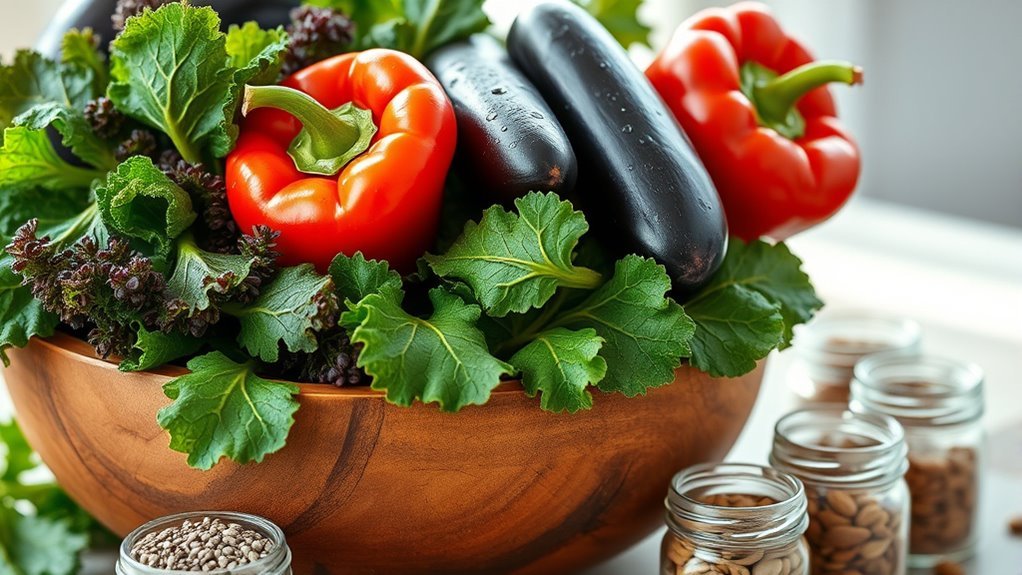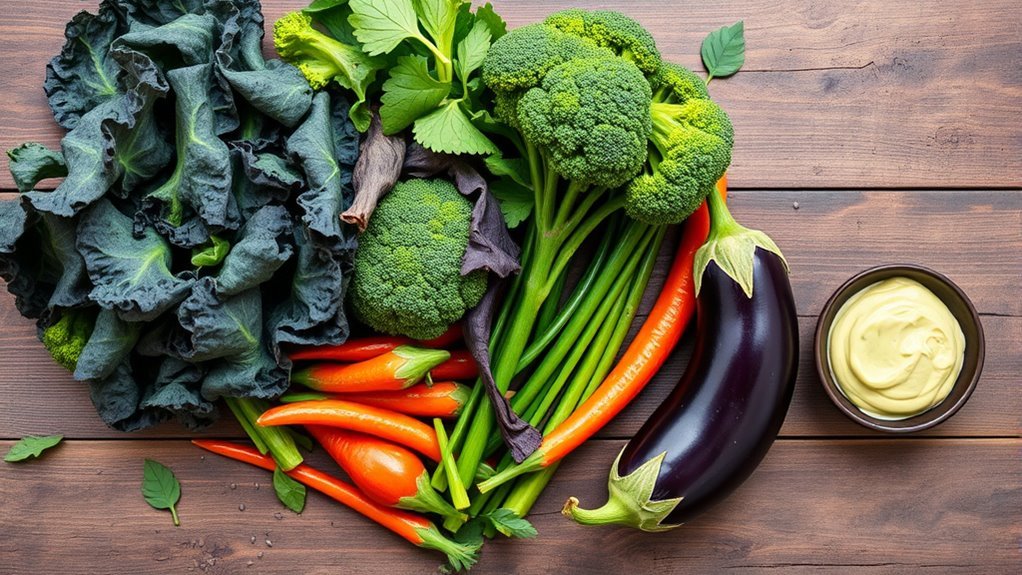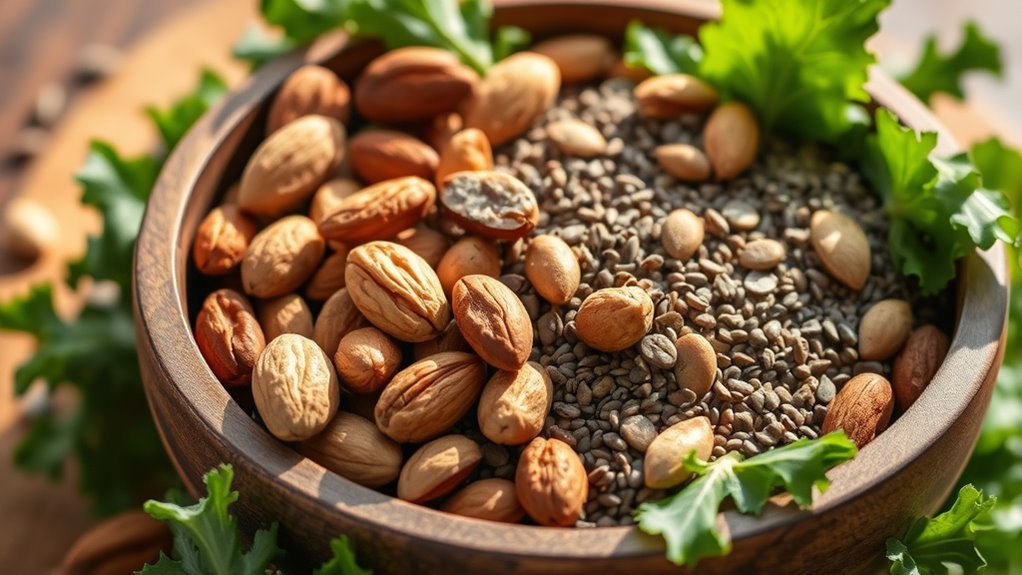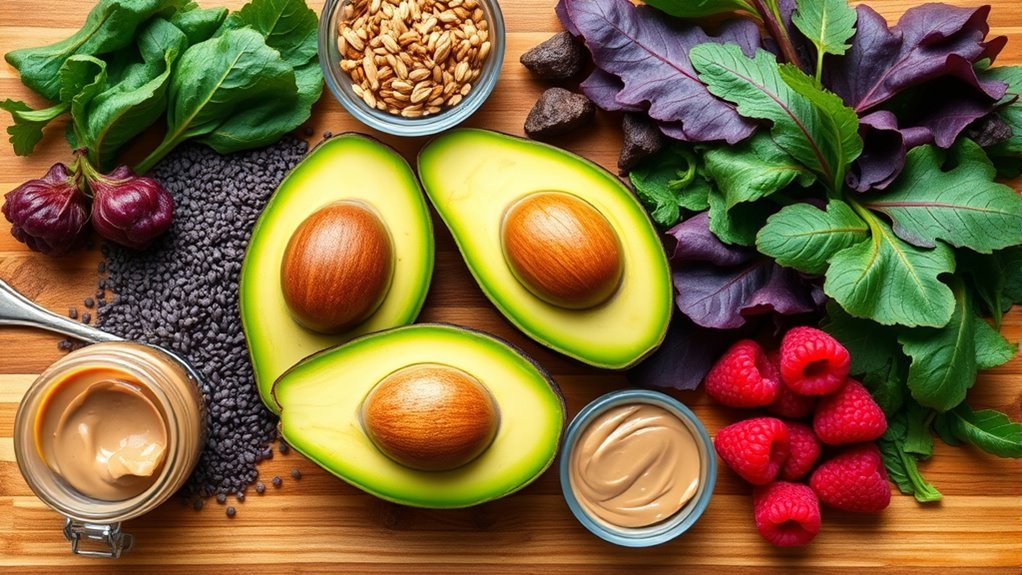To boost your fiber intake on a keto diet, focus on low-carb vegetables like broccoli, spinach, and Brussels sprouts. Incorporate nutrient-rich nuts and seeds, such as almonds and chia seeds, for healthy snacking. Don’t forget avocados, which are high in fiber and healthy fats. You can also consider supplements like psyllium husk to meet your fiber goals. Discover more creative ways to enhance your meals and keep your fiber intake on track.
Understanding Fiber and Its Importance on Keto

When you’re on a keto diet, understanding fiber’s role becomes vital, as it not only aids digestion but also supports overall health. Fiber types can generally be categorized into soluble and insoluble fibers, each playing a unique role in digestive health. Soluble fiber helps manage blood sugar levels and can even promote a feeling of fullness, which is beneficial on a lower-carb regimen. On the other hand, insoluble fiber adds bulk to your stool, helping to prevent constipation—a common concern for those on keto. While you’re cutting carbs, it’s essential to include high-fiber foods to maintain regularity and overall well-being. Staying informed about fiber types empowers you to make the best choices for your keto journey, allowing you to enjoy greater freedom in your dietary choices. Additionally, incorporating low-carb vegetables into your meals can significantly boost your fiber intake while adhering to keto principles.
Low-Carb Vegetables Packed With Fiber

When you’re on a keto diet, incorporating low-carb vegetables can greatly boost your fiber intake. Certain veggies not only offer essential nutrients but also provide effective cooking methods to preserve their fiber content. Let’s explore some of the best fiber-rich options and how to easily add them to your meals. Additionally, including leafy greens in your diet can further enhance your overall health and fiber intake.
Best Fiber-Rich Veggies
Although many people associate the keto diet with meat and dairy, incorporating fiber-rich vegetables can greatly enhance your nutritional intake. When you’re looking for the best fiber sources on a low-carb diet, consider options like broccoli, spinach, and Brussels sprouts. These veggies not only provide essential nutrients but also offer substantial fiber without spiking your carb intake. Artichokes and avocados are excellent choices too, as they’re both low in carbs and high in fiber. If you find it challenging to meet your fiber needs through food alone, fiber supplements can be a helpful addition. Remember, the goal is to maintain digestive health while enjoying the freedom of a versatile keto lifestyle. Broccoli, for instance, is particularly compatible with keto principles due to its low net carb count, making it an ideal choice for those on a ketogenic diet.
Cooking Methods for Fiber
Incorporating fiber-rich vegetables into your keto diet isn’t just about choosing the right produce; how you prepare those vegetables can greatly impact their nutritional benefits. For ideal fiber cooking, consider steaming or sautéing rather than boiling, as these methods help preserve the fiber content. Roasting vegetables can also enhance their flavor while keeping their fiber intact. When it comes to fiber preparation, chopping or shredding veggies can make them easier to digest, maximizing the absorption of nutrients. You might also try blending leafy greens into smoothies, which allows for easy consumption. Including leafy greens in your meals not only boosts fiber intake but also adds essential vitamins and minerals. By experimenting with these cooking techniques, you’ll enjoy a flavorful, fiber-packed keto diet that aligns with your health goals and provides freedom in your culinary choices.
Incorporating Vegetables Easily
To seamlessly include low-carb, fiber-rich vegetables in your keto diet, focus on a variety of options that not only fit your macro goals but also enhance your meals. Leafy greens like spinach and kale are great choices, as they’re low in carbs while packing essential nutrients. Cruciferous vegetables like broccoli and cauliflower also provide fiber without tipping your carb balance. Consider incorporating these veggies into your keto meal prepping routine by roasting or sautéing them for easy access. For a revitalizing twist, whip up vegetable smoothies with ingredients like spinach and avocado, ensuring you add healthy fats for a filling snack. By creatively integrating these vegetables, you’ll boost your fiber intake and keep your meals exciting. Additionally, including cruciferous vegetables like Brussels sprouts can further diversify your nutrient intake while maintaining low carbohydrate levels.
Nuts and Seeds: Fiber-Rich Snacks for Keto

While many people might think of fiber as a challenge on a keto diet, nuts and seeds offer a convenient and delicious solution. Including various nut varieties like almonds, walnuts, and pecans can boost your fiber intake while providing healthy fats. Likewise, seeds such as chia, flax, and pumpkin are packed with nutrients and fiber, making them excellent choices for snacking. Nutritional yeast can also be considered as a flavor enhancer while being low in carbohydrates and rich in essential vitamins and minerals.
Here’s a quick comparison of fiber content in popular nuts and seeds:
| Food Item | Serving Size | Fiber (g) |
|---|---|---|
| Almonds | 1 oz | 3.5 |
| Chia Seeds | 1 oz | 10.6 |
| Walnuts | 1 oz | 2.0 |
| Flaxseeds | 1 oz | 7.7 |
Incorporating these options into your meals can enhance your fiber intake effortlessly.
Incorporating Avocados Into Your Diet
Avocados are an excellent addition to your keto diet, offering a wealth of nutritional benefits, including healthy fats and fiber. Not only do they help you meet your fiber goals, but they can also be used in a variety of creative recipes. Incorporating avocados into your meals can enhance both flavor and nutrition, making your keto journey more enjoyable. Their high fiber content further supports your digestive health while keeping your carb intake low.
Nutritional Benefits of Avocados
Incorporating avocados into your diet can greatly enhance your nutritional intake, especially when following a keto diet. Avocados are rich in healthy fats, primarily monounsaturated fat, which supports heart health and helps you feel full longer. They’re also a fantastic source of fiber, providing about 10 grams per medium avocado, which is essential for digestive health. The avocado benefits extend beyond just macronutrients; they’re packed with vitamins C, E, K, and B vitamins, as well as potassium. This nutrient-dense fruit can easily fit into various avocado recipes, ensuring you get a delicious way to boost your nutrient intake. By adding avocados to your meals, you’ll not only enjoy their creamy texture but also reap the numerous health benefits they offer. Their low net carb count makes them an excellent choice for maintaining ketosis while enjoying a variety of flavors.
Creative Avocado Recipes
Have you ever wondered how to elevate your meals with the creamy goodness of avocados? These versatile fruits can add flavor and nutritional value to your diet. Try whipping up avocado smoothies for a rejuvenating breakfast packed with healthy fats and fiber. Simply blend avocados with your favorite low-carb ingredients like spinach and nut milk.
Another delicious option is spicy avocado toast. Spread mashed avocado on low-carb bread and top it with chili flakes or hot sauce for an extra kick. Incorporating keto-friendly fats into your meals, like avocados, is essential for embracing the ketogenic lifestyle effectively.
Here’s a quick reference table for more avocado ideas:
| Recipe | Ingredients | Fiber Content (g) |
|---|---|---|
| Avocado Smoothie | Avocado, spinach, nut milk | 8 |
| Spicy Avocado Toast | Avocado, low-carb bread, spices | 5 |
| Guacamole | Avocado, lime, cilantro | 6 |
| Avocado Salad | Avocado, greens, vinaigrette | 7 |
| Avocado Egg Bake | Avocado, eggs, cheese | 4 |
Exploring Keto-Friendly Legumes
While many people associate legumes with high carbohydrate content, some varieties can fit surprisingly well into a keto diet when consumed in moderation. Keto legumes, such as green beans and black soybeans, are excellent choices due to their lower carb counts and higher fiber content. Incorporating these legumes can boost your fiber sources, making it easier to meet your daily requirements. For instance, a half-cup of cooked black soybeans contains about 8 grams of fiber and only 4 grams of net carbs. This makes them a great option for adding protein and fiber without derailing your keto goals. Just keep portion sizes in mind, and you can enjoy the benefits of these nutrient-rich foods while maintaining your ketogenic lifestyle. Additionally, it’s important to remember that balancing intake of beans with low-carb foods supports ketosis.
The Role of Psyllium Husk and Other Supplements
Psyllium husk stands out as a powerful supplement for those on a keto diet looking to increase their fiber intake. It’s well-known for its psyllium benefits, including promoting digestive health and stabilizing blood sugar levels. If you’re considering supplement options, here’s a quick comparison to help you decide:
| Supplement | Fiber Content (per serving) | Main Benefits |
|---|---|---|
| Psyllium Husk | 7g | Supports digestion, reduces cholesterol |
| Chia Seeds | 10g | High in omega-3s, promotes fullness |
| Flaxseeds | 8g | Rich in lignans, aids digestion |
Incorporating these supplements can help you meet your fiber needs without straying from your keto lifestyle. Explore these options to discover what works best for you!
Creative Ways to Add Fiber to Your Meals
Finding ways to incorporate fiber into your meals on a keto diet can be both enjoyable and rewarding. You don’t have to sacrifice taste for nutrition; instead, get creative! Here are some ideas to boost your fiber intake:
Incorporating fiber into your keto meals can be delicious and fun—get creative for a nutritious boost!
- Blend fiber rich smoothies with spinach, avocado, and chia seeds for a delicious start to your day.
- Add creative toppings to salads, like sunflower seeds or hemp hearts, for an extra crunch.
- Use almond flour or coconut flour in baking to increase fiber content without compromising your carb count.
- Experiment with vegetables like artichokes and Brussels sprouts, which are low in carbs and high in fiber.
Delicious Keto Recipes High in Fiber
Incorporating fiber-rich recipes into your keto meal plan can elevate both your nutritional intake and satisfaction with your diet. Here are a couple of delicious options to reflect on:
| Recipe | Key Ingredients | Fiber Content (g) |
|---|---|---|
| Fiber Rich Smoothie | Spinach, avocado, chia seeds | 10 |
| Keto Bread | Almond flour, psyllium husk | 7 |
| Zucchini Noodles | Zucchini, olive oil, garlic | 4 |
| Cauliflower Rice | Cauliflower, spices, herbs | 5 |
These recipes not only provide essential fiber but also keep your meals exciting. Enjoy the freedom of customizing these dishes while ensuring you meet your fiber goals on keto!
Frequently Asked Questions
Can I Get Enough Fiber Without Eating Fruits?
Yes, you can definitely get enough fiber without eating fruits. Focus on vegetable sources like leafy greens, broccoli, and cauliflower, as they’re low in carbs and high in fiber. Additionally, consider fiber alternatives such as chia seeds, flaxseeds, and psyllium husk. These options can help you maintain your fiber intake while sticking to your dietary preferences. Just remember to stay hydrated, as increased fiber can require more water for ideal digestion.
Is Fiber Supplementation Safe While on a Keto Diet?
Fiber supplementation can be safe while you’re on a keto diet, like adding a sturdy anchor to a boat. It helps stabilize your digestive health without jeopardizing your carb limits. Supplementation benefits include improved gut health and regularity, especially when fiber sources from food are limited. However, it’s essential to consult with a healthcare provider to tailor the right amount for your needs, ensuring a balanced approach while enjoying your keto freedom.
How Does Fiber Impact Ketosis?
Fiber doesn’t directly impact ketosis, but it plays an essential role in your overall health while on a keto diet. There are two fiber types: soluble and insoluble. Soluble fiber can help manage blood sugar levels, while insoluble fiber aids digestion, promoting ketosis benefits. By ensuring you get enough fiber, you can maintain gut health and enhance nutrient absorption, allowing you to enjoy the freedom and flexibility of a sustainable ketogenic lifestyle.
What Are the Symptoms of Fiber Deficiency on Keto?
If you’re not getting enough fiber on keto, you might experience symptoms like constipation, bloating, and digestive discomfort. Picture a healthy gut; it’s thriving on fiber-rich recipes from keto-friendly vegetables like spinach and broccoli. Without these fiber sources, your digestive health can suffer, making it essential to find that balance. Don’t underestimate the importance of fiber in your diet; it’s key for maintaining overall wellness while enjoying the freedom of keto.
Can I Track Fiber Intake With Keto Apps?
Yes, you can track fiber intake with keto apps. Many keto calculators include fiber tracking features, allowing you to monitor your daily intake easily. By logging your meals, you’ll see how much fiber you’re consuming alongside your other macronutrients. This can help guarantee you’re meeting your dietary needs while enjoying the freedom of a keto lifestyle. Just remember to choose low-carb, high-fiber foods to maintain that balance effectively.


